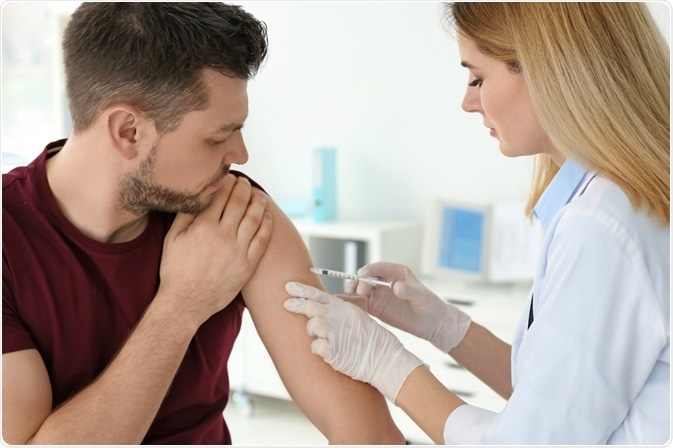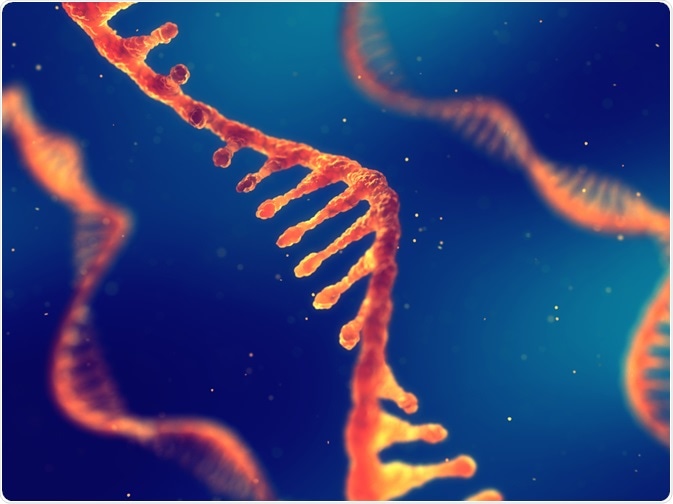RNA vaccines are a new class of vaccines that are composed of an mRNA sequence coding for a pathogen-specific protein (antigen). Once expressed in the body, the target antigen is recognized by the immune system, leading to the induction of desired immune responses.
 Image Credit: Africa Studio/Shutterstock.com
Image Credit: Africa Studio/Shutterstock.com
What is an RNA vaccine?
RNA vaccines are safer to use even in immunocompromised patients as these vaccines do not contain any infectious agents. The cheaper and faster manufacturing process makes RNA vaccines very efficacious in combating rapidly evolving pathogens (influenza virus) and contagious disease outbreaks (Ebola, Zika, and COVID-19). In addition, RNA vaccines could potentially be used to manage severe health conditions, such as cancer.
In RNA vaccines, no live/inactivated pathogen or pathogen-specific antigen is directly inserted into the human body. Instead, an mRNA sequence containing the genetic sequence of a pathogen-specific antigen is inserted into the body. This mRNA sequence is then utilized by the host cell’s protein-synthesizing machinery as a template to produce the target antigen.
Once produced, the target antigen is displayed on the cell surface so that specialized immune cells can recognize it and induce pathogen-specific immune responses.
How RNA vaccines are administered?
To trigger a robust and sustained immune response, mRNA vaccines must cross the plasma membrane efficiently. There are several ways to administer RNA vaccines effectively into the body. Administration of the naked mRNA vaccine via intradermal or intranodal injection is an effective way to enhance antigen presentation. The in vivo electroporation method is another good approach for increasing the release of a vaccine into the cytoplasm.
To increase the stability, expression, and immunogenicity of vaccine mRNA, small nuclear proteins, such as protamine, are combined with mRNA sequence. In addition, lipid- and polymer-based nanoparticles are combined with mRNA sequences to significantly improve vaccine efficacy.
Regarding routes of administration, intradermal injection of lipid nanoparticle-based mRNA vaccines is known to induce both antibody-mediated and T cell-mediated immune responses, probably because of the high prevalence of antigen-presenting cells in the skin.
Moreover, the amount of antigen produced, and the duration of antigen expression is highest in intravenous and intradermal and intramuscular administrations, respectively.
How mRNA vaccines work
What are the types of RNA vaccines?
There are three types of RNA vaccines: non-replicating mRNA vaccines; self-replicating mRNA vaccines; and in vitro dendritic cell non-replicating mRNA vaccines.
Non-replicating mRNA vaccines
Non-replicating mRNA vaccines include an mRNA sequence coding for a target antigen, which is flanked by 3’ and 5’ untranslated regions (UTRs). The mRNA sequence is small in size and easy to construct as it does not contain any additional protein-coding sequences to support the self-replication of the mRNA.
A plasmid DNA template produced in E. coli is transcribed in vitro to generate vaccine mRNA of interest. The mRNA sequence is then purified using HPLC to get rid of all byproducts. The eukaryotic or viral UTRs included in the mRNA sequence increase the half-life and stability of the sequence, leading to increased expression of the target antigen.
Self-replicating mRNA vaccines
In self-replicating mRNA vaccines, a viral genome is used, in which the viral gene sequence responsible for coding structural proteins is replaced by the antigen sequence of interest. The viral RNA sequence generated in this way can still replicate and can be transcribed using viral RNA polymerase.
Although the construction process of self-replicating mRNA vaccines is more complicated than non-replicating mRNA vaccines, a significantly higher amplification rate of antigen coding mRNA sequence makes self-replicating vaccines more advantageous in terms of significantly higher production of the target antigen from relatively low vaccine doses.
In vitro dendritic cell non-replicating mRNA vaccines
Dendritic cells are antigen-presenting cells that express antigens on the cell surface so that specialized immune cells, such as T cells, can recognize the antigen and initiate cellular immune responses. For in vitro dendritic cell non-replicating mRNA vaccines, dendritic cells are isolated from the patient’s blood, transfected with the mRNA sequence of interest, and administered back to the patient to induce desired immune responses.
How do RNA vaccines work?
Upon administration, the vaccine mRNA is recognized by a variety of receptors located in the endosomes and cytoplasm. The mRNA-mediated activation of these receptors subsequently induces a strong innate immune response, which is characterized by the production of proinflammatory mediators (cytokines and chemokines). These mediators play vital roles in inducing appropriate adaptive immune responses against the target antigen.
The activation of the innate immune system is restricted to the site of vaccine injection and lymph nodes. Afterward, cells surrounding the injection site, such as antigen-presenting cells, rapidly uptake the vaccine mRNA, leading to translation of the mRNA and robust expression of the target antigen inside these specialized cells. The antigen is then presented on the cell surface and recognized by the immune cells, leading to the induction of adaptive immune responses.
 Image Credit: nobeastsofierce/Shutterstock.com
Image Credit: nobeastsofierce/Shutterstock.com
RNA vaccines in cancer
Many clinical trials are currently undergoing to test the efficacy of RNA vaccines in treating a wide variety of cancers, such as melanoma, glioblastoma, prostate cancer, and leukemia. The mRNA sequences coding for cancer-specific antigens are used in these vaccines.
In personalized cancer vaccines, the tumor genomes obtained from cancer patients are sequenced, and mRNAs coding for patient-specific cancer-related mutant proteins are generated. Personalized RNA vaccines made in this way are effective in inducing strong immune responses to destroy cancer cells.
Will an RNA vaccine alter your DNA?
RNA vaccines altering DNA has been a concern expressed by some of the population when hearing about RNA vaccines. However, an RNA vaccine cannot change a patient’s DNA.
The mRNA in RNA vaccines cannot combine with our DNA to change its code. In fact, when it travels into the cell, it stays in the cytosol and cannot cross the nuclear membrane to enter the nucleus where genetic material is stored. Furthermore, mRNA is fragile and degrades quickly inside our cells (after around 72 hours).
Strands of mRNA from RNA vaccines provide instructions for the machinery in our cells to make proteins in the same way that our natural immune system does. A virus infects our cells and injects its material into our cells. This results in pieces of mRNA that correspond to the virus’s viral proteins being sent to our cellular machinery, which is instructed to make proteins to respond to infection.
This is the same as what happens with an RNA vaccine – mRNA encoding for proteins that will fight a specific virus enters our cells, resulting in the production of these proteins.
There are certain viruses, retroviruses such as HIV, that can integrate with host DNA due to specialized enzymes enabling the virus to cross the nuclear membrane. Primers then allow them to transcribe DNA from RNA. However, mRNA vaccines do not contain the enzymes to cross the nuclear membrane, and even if they could, they would not contain the primers to activate transcription of RNA to DNA.
References
Further Reading
Last Updated: Mar 17, 2021